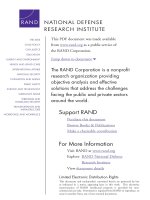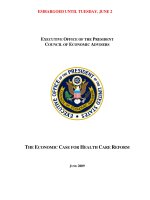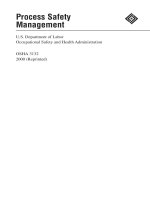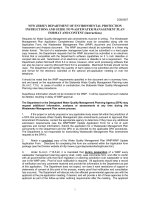Department of Homeland Security Office of Inspector General pot
Bạn đang xem bản rút gọn của tài liệu. Xem và tải ngay bản đầy đủ của tài liệu tại đây (699.26 KB, 28 trang )
Department of Homeland Security
Office of Inspector General
Information Technology Management Letter for the
FY 2009 Immigration Customs Enforcement
Financial Integrated Audit
OIG-10-87 May 2010
Office of Inspector General
U.S. Department of Homeland Security
Washington, DC 25028
May 18, 2010
Preface
The Department of Homeland Security (DHS) Office of Inspector General (OIG) was established
by the Homeland Security Act of 2002 (Public Law 107-296) by amendment to the Inspector
General Act of 1978. This is one of a series of audit, inspection, and special reports prepared as
part of our oversight responsibilities to promote economy, efficiency, and effectiveness within
the department.
This report presents the information technology (IT) management letter for the FY 2009
Immigration and Custom Enforcement (ICE) financial statement audit as of September 30, 2009.
It contains observations and recommendations related to information technology internal control
that were summarized in the Independent Auditors’ Report, dated December 18, 2009 and
presents the separate restricted distribution report mentioned in that report. The independent
accounting firm KPMG LLP (KPMG) performed the audit procedures at ICE in support of the
DHS FY 2009 financial statements and prepared this IT management letter. KPMG is
responsible for the attached IT management letter dated April 1, 2010, and the conclusions
expressed in it. We do not express opinions on DHS’ financial statements or internal control or
conclusion on compliance with laws and regulations.
The recommendations herein have been developed to the best knowledge available to our office,
and have been discussed in draft with those responsible for implementation. We trust that this
report will result in more effective, efficient, and economical operations. We express our
appreciation to all of those who contributed to the preparation of this report.
Frank Deffer
Assistant Inspector General for
Information Technology Audits
KPMG LLP
2001 M Street, NW
Washington, DC 20036
April 1, 2010
Inspector General
U.S. Department of Homeland Security
Chief Information Officer and
Chief Financial Officer
Immigration and Customs Enforcement
Ladies and Gentlem
en:
We have audited the consolidated balance sheet of the Immigration and Customs Enforcement
(ICE), a component of the U.S. Department of Homeland Security (DHS), as of September 30, 2009
and the related consolidated statements of net cost, changes in net position, and the combined
statement of budgetary resources (hereinafter referred to as “consolidated financial statements”) for
the year then ended. In planning and performing our audit of the consolidated financial statements
of ICE, in accordance with auditing standards generally accepted in the United States of America,
we considered ICE’s internal control over financial reporting (internal control) as a basis for
designing our auditing procedures for the purpose of expressing our opinion on the consolidated
financial statements but not for the purpose of expressing an opinion on the effectiveness of ICE’s
internal control. Accordingly, we do not express an opinion on the effectiveness of ICE’s internal
control.
In planning and performing our fiscal year 2009 audit, we considered ICE’s internal control over
financial reporting by obtaining an understanding of the design effectiveness of ICE’s internal
control, determining whether internal controls had been placed in operation, assessing control risk,
and performing tests of controls as a basis for designing our auditing procedures for the purpose of
expressing our opinion on the consolidated financial statements. To achieve this purpose, we did
not test all internal controls relevant to operating objectives as broadly defined by the Federal
Managers’ Financial Integrity Act of 1982. The objective of our audit was not to express an
opinion on the effectiveness of ICE’s internal control over financial reporting. Accordingly, we do
not express an opinion on the effectiveness of ICE’s internal control over financial reporting.
A deficiency in internal control exists when the design or operation of a control does not allow
management or employees, in the normal course of performing their assigned functions, to prevent,
or detect and correct misstatements on a timely basis. A significant deficiency is a deficiency, or a
combination of deficiencies, in internal control that is less severe than a material weakness, yet
important enough to merit attention by those charged with governance. A material weakness is a
deficiency, or a combination of deficiencies, in internal control, such that there is a reasonable
possibility that a material misstatement of the entity’s financial statements will not be prevented, or
detected and corrected on a timely basis.
Our audit of ICE as of, and for the year ended, September 30, 2009 disclosed a material weakness in
the areas of information technology (IT) configuration management, security management, access
controls, and segregation of duties. These matters are described in the IT General Control Findings
by Audit Area section of this letter.
KPMG LLP, a U.S. limited liability partnership, is the U.S.
member firm of KPMG International, a Swiss cooperative.
The material weakness described above is presented in our Independent Auditors’ Report, dated
December 18, 2009. This letter represents the separate restricted distribution letter mentioned in
that report.
The control deficiencies described herein have been discussed with the appropriate members of
management, and communicated through a Notice of Finding and Recommendation (NFR). Our
audit procedures are designed primarily to enable us to form an opinion on the consolidated
financial statements, and therefore may not bring to light all weaknesses in policies or procedures
that may exist. We aim to use our knowledge of ICE gained during our audit engagement to make
comments and suggestions that are intended to improve internal control over financial reporting or
result in other operating efficiencies.
The Table of Contents on the next page identifies each section of the letter. We have provided a
description of key ICE financial systems and IT infrastructure within the scope of the FY 2009 ICE
consolidated financial statement audit in Appendix A; a description of each internal control finding
in Appendix B; and the current status of the prior year NFRs in Appendix C. Our comments related
to certain additional matters have been presented in a separate letter to the Office of Inspector
General and the ICE Chief Financial Officer dated December 9, 2009.
This communication is intended solely for the information and use of DHS and ICE management,
DHS Office of Inspector General, OMB, U.S. Government Accountability Office, and the U.S.
Congress, and is not intended to be and should not be used by anyone other than these specified
parties.
Very truly yours,
Department of Homeland Security
Immigration and Customs Enforcement
Information Technology Management Letter
September 30, 2009
INFORMATION TECHNOLOGY MANAGEMENT LETTER
TABLE OF CONTENTS
Page
Objective, Scope and Approach
1
Summary of Findings and Recommendations
3
IT General Control Findings by Audit Area
4
Findings Contributing to a Material Weakness in IT
4
Configuration Management
4
Security Management (includes After-Hours Physical Security Testing)
4
Access Controls
5
5
Segregation of Duties
Application Controls
9
Management’s Comments and OIG Response
9
APPENDICES
Appendix Subject Page
Description of Key ICE Financial Systems and IT Infrastructure within the Scope of the
A
10
FY 2009 DHS Financial Statement Audit Engagement
B
FY 2009 Notices of IT Findings and Recommendations at ICE
12
- Notice of Findings and Recommendations – Definition of
Severity Ratings
13
Status of Prior Year Notices of Findings and Recommendations and Comparison to
C
Current Year Notices of Findings and Recommendations at ICE
19
D
Management’s Comments
21
E
Report Distribution
22
Department of Homeland Security
Immigration and Customs Enforcement
Information Technology Management Letter
September 30, 2009
OBJECTIVE, SCOPE AND APPROACH
We have audited the Immigration and Custom Enforcement (ICE) agency’s balance sheet as of
September 30, 2009. In connection with our audit of ICE’s balance sheet, we performed an
evaluation of information technology general controls (ITGC), to assist in planning and performing
our audit. The Federal Information System Controls Audit Manual (FISCAM), issued by the
Government Accountability Office (GAO), formed the basis of our ITGC evaluation procedures.
The scope of the ITGC evaluation is further described in Appendix A.
FISCAM was designed to inform financial auditors about IT controls and related audit concerns to
assist them in planning their audit work and to integrate the work of auditors with other aspects of
the financial audit. FISCAM also provides guidance to IT auditors when considering the scope and
extent of review that generally should be performed when evaluating general controls and the IT
environment of a federal agency. FISCAM defines the following five control functions to be
essential to the effective operation of the general IT controls environment.
�
�
�
�
�
Security Man
agement (SM) – Controls that provide a framework and continuing cycle of
activity for managing risk, developing security policies, assigning responsibilities, and
monitoring the adequacy of computer-related security controls.
Access Control (AC) – Controls that limit or detect access to computer resources (data,
programs, equipment, and facilities) and protect against unauthorized modification, loss, and
disclosure.
Configuration Management (CM) – Controls that help to prevent unauthorized changes to
information system resources (software programs and hardware configurations) and provides
reasonable assurance that systems are configured and operating securely and as intended.
Segregation of duties (SD) – Controls that constitute policies, procedures, and an organizational
structure to manage who can control key aspects of computer-related operations.
Contingency Planning (CP) – Controls that involve procedures for continuing critical operations
without interruption, or with prompt resumption, when unexpected events occur.
To complement our general IT controls audit procedures, we also performed technical security
testing for key network and system devices, as well as testing over key financial application
controls in the ICE environment. The technical security testing was performed both over the
Internet and from within select ICE facilities, and focused on test, development, and production
devices that directly support key general support systems.
1
Information Technology
Management Letter for the FY 2009 ICE Financial Statement Audit
Department of Homeland Security
Immigration and Customs Enforcement
Information Technology Management Letter
September 30, 2009
In addition to testing ICE’s general control environment, we performed application control tests on
a limited number of ICE’s financial systems and applications. The application control testing was
performed to assess the controls that support the financial systems’ internal controls over the input,
processing, and output of financial data and transactions.
� Application Controls
(APC) - Application controls are the structure, policies, and
procedures that apply to separate, individual application systems, such as accounts payable,
inventory, or payroll.
2
Information Technology
Management Letter for the FY 2009 ICE Financial Statement Audit
Department of Homeland Security
Immigration and Customs Enforcement
Information Technology Management Letter
September 30, 2009
SUMMARY OF FINDINGS AND RECOMMENDATIONS
During fiscal year (FY) 2009, ICE took corrective action to address prior year IT control
weaknesses. For example, ICE made improvements over tracking and maintaining Active
Directory Exchange (ADEX) user access forms and securing its backup facility from unauthorized
access. However, during FY 2009, we continued to identify IT general control weaknesses that
could potentially impact ICE’s financial data. The most significant weaknesses from a financial
statement audit perspective related to controls over the Federal Financial Management System
(FFMS) and the weaknesses over physical security and security awareness. Collectively, the IT
control weaknesses limited ICE’s ability to ensure that critical financial and operational data were
maintained in such a manner to ensure confidentiality, integrity, and availability. In addition, these
weaknesses negatively impacted the internal controls over ICE financial reporting and its operation
and we consider them to collectively represent a material weakness for ICE under standards
established by the American Institute of Certified Public Accountants (AICPA). In addition, based
upon the results of our test work, we noted that ICE did not fully comply with the requirements of
the Federal Financial Management Improvement Act (FFMIA).
Of the 14 findings identified during our FY 2009 testing, all were new IT findings. These findings
represent weaknesses in four of the five FISCAM key control areas. Specifically these weakness
are: 1) unverified access controls through the lack of comprehensive user access privilege re-
certifications, 2) security management issues involving staff security training, exit processing
procedures and contractor background investigation weaknesses, 3) inadequately designed and
operating configuration management, and 4) lack of effective segregation of duties controls within
financial applications. These weaknesses may increase the risk that the confidentiality, integrity,
and availability of system controls and ICE financial data could be exploited thereby compromising
the integrity of financial data used by management and reported in ICE’s financial statements.
While the recommendations made by KPMG should be considered by ICE, it is the ultimate
responsibility of ICE management to determine the most appropriate method(s) for addressing the
weaknesses identified based on their system capabilities and available resources.
3
Information Technology
Management Letter for the FY 2009 ICE Financial Statement Audit
Department of Homeland Security
Immigration and Customs Enforcement
Information Technology Management Letter
September 30, 2009
IT GENERAL CONTROL FINDINGS BY AUDIT AREA
Findings Contributing to a Material Weakness Deficiency in IT
During the FY 2009 financial statement audit, we identified the following IT and financial system
control deficiencies that in the aggregate are considered a material deficiency:
1. Configuration Management – we identified:
� Security configuration management weaknesses on ADEX. These weaknesses included
default configuration settings, inadequate patches, and weak password management.
2. Security Management – we identified:
�
�
During social engineering testing, 5 out of
20 staff provided their login and password.
Physical security weaknesses which identified improper protection of system user
names and passwords, unsecured information security hardware, documentation
containing Personally Identifiable Information (PII) or marked “For Official Use Only”,
and unlocked network sessions. The specific results are listed below:
Exceptions Noted
ICE Locations Tested
Total
Exceptions by
Type
OFM
TechWorld
10
th
floor
OCIO PCN
3
rd
floor
OCFO PCN
4
th
floor
User Name and
Passwords
19 3 4
26
For Official Use Only
(FOUO)
1 2 1
4
Keys/Badges
0 1 1
2
Personally Identifiable
Information (PII)
13 2 0
15
Server Names/IP
Addresses
0 2 0
2
Laptops
1 2 0
3
External Drives
2 3 1
6
Credit Cards
1 0 0
1
Classified Documents
0 0 0
0
Other - Describe
1 personal
checkbook
1 workstation
logged in w\o
screensaver
activated
1 workstation
logged in w\o
screensaver
activated
3
Total Exceptions by
Location
38 16 8 62
4
Information Technology Management Letter for the FY 2009 ICE Financial Statement Audit
Department of Homeland Security
Immigration and Customs Enforcement
Information Technology Management Letter
September 30, 2009
�
�
�
Procedures for transferred and terminated personnel exit processing are not being
consistently followed.
Background reinvestigations for contractors were not consistently performed.
IT Security training is not mandatory nor is compliance monitored.
3. Access controls – we identified:
�
�
�
�
�
A lack of recertification of ADEX and FFMS sy
stem users.
ADEX account lockout settings are not compliant with DHS policy.
ADEX system access was not consistently removed for terminated employees and
contractors.
FFMS password settings are not compliant with DHS policy.
Physical security personnel are not adequately trained to detect non-conforming credentials
that can be used to gain unauthorized access.
4. Segregation of Duties – we identified:
� FFMS roles and responsibi
lities for the Originator, Funds Certification Official, and
Approving Official profiles were not effectively segregated.
Recommendations: We recommend that the ICE Chief Information Officer (CIO) and Chief
Financial Officer (CFO), in coordination with the DHS Office of Chief Financial Officer and the
DHS Office of the Chief Information Officer, make the following improvements to ICE’s financial
management systems and associated information technology security program.
Configuration Management:
1. Redistribute procedures and train employees on continuously monitoring and mitigating
vulnerabilities. In addition, we recommend that ICE periodically monitor the existence of
unnecessary services and protocols running on their servers and network devices, in
addition to deploying patches.
2. Perform vulnerability assessments and penetration tests on all offices of the ICE, from a
centrally managed location with a standardized reporting mechanism that allows for
trending, on a regularly scheduled basis in accordance with NIST guidance.
3. Develop a more thorough approach to track and mitigate configuration management and
resource vulnerabilities identified during monthly scans. ICE should monitor the
vulnerability reports for necessary or required configuration changes to its environment.
4. Develop a process to verify that systems identified with “HIGH/MEDIUM Risk”
configuration vulnerabilities do not appear on subsequent monthly vulnerability scan
reports, unless they are verified and documented as a false-positive. All risks identified
during the monthly scans should be mitigated immediately, and not be allowed to remain
dormant.
5. Implement the corrective actions identified during the audit vulnerability assessment.
5
Information Technology Management Letter for the FY 2009 ICE Financial Statement Audit
Department of Homeland Security
Immigration and Customs Enforcement
Information Technology Management Letter
September 30, 2009
Security Management:
1. Ensure that users are trained and aware of safeguarding login credentials, locking network
sessions to DHS systems, and locking any sensitive information, media containing sensitive
information, or data not suitable for public dissemination in secure locations when not in
use.
2. Effectively limit access to DHS buildings, rooms, work areas, spaces, and structures
housing IT systems, equipment, and data to authorized personnel.
3. Adhere to exit clearance procedures and require personnel to follow them in the event of
transfer\termination.
4. Periodically review personnel files to confirm background reinvestigations have been
completed in accordance with DHS standards.
5. Implement mandatory requirements for IT security personnel to complete training
consistent with their job function duties.
6. Remove system access for personnel that are not in compliance with training requirements.
In addition, document procedures regarding disabling user accounts and access privileges in
accordance with DHS policy.
Access Controls:
1. Establish and implement policies and procedures for recertification of system user
privileges. This process should include a method to document user recertification and a
process to maintain evidence of the reviews.
2. Develop processes for the removal of transferred and terminated users within ADEX upon
their separation.
3. Modify ADEX lockout settings to comply with DHS policy.
4. Update FFMS password configuration settings to comply with DHS policy.
5. Train physical security personnel to recognize DHS issued identification and to deter non-
conforming credentials.
Segregation of Duties:
1. Enforce policies and procedures to ensure that assigned roles and responsibilities are
commensurate with personnel job functions.
6
Information Technology
Management Letter for the FY 2009 ICE Financial Statement Audit
Department of Homeland Security
Immigration and Customs Enforcement
Information Technology Management Letter
September 30, 2009
Cause\Effect:
The ICE agency is not continuously monitoring the ICE ADEX General Support System (GSS)
vulnerability assessment scans for patch and configuration management vulnerabilities. As a result,
default configuration installations and unnecessary services operating on the ICE ADEX devices
increase the ability to compromise the availability, integrity, and confidentiality of financial data on
the network. Additionally, failure to apply critical vendor security patches exposes system and
network devices to new and existing vulnerabilities. This can expose the information system
controls environment to security breaches, unauthorized access, service interruptions, and denial of
service attacks.
ICE management has not ensured that personnel are adequately trained and aware of the basic IT
security policies described by DHS to ensure that system users are cognizant of computer security
principles. Without proper training and awareness, system users could potentially provide
unauthorized persons information to gain access to ICE resources and sensitive data that may result
in loss, damage, or theft.
ICE management has not ensured that personnel are adequately trained and aware of the basic IT
security policies described by DHS and ICE to protect their login credentials, lock network sessions
to DHS systems, secure information system hardware, and securely store/limit access to FOUO and
PII. The failure to control access to sensitive IT resources and ICE documentation could potentially
result in the theft or destruction of ICE assets, unauthorized access to sensitive information, and
disruptions in processing of ICE financial systems. Additionally, ICE personnel who are not
adequately trained to protect their login credentials present an increased risk of unauthorized access
to sensitive information from external and internal threats.
ICE personnel are not consistently complying with, or are unaware of, existing exit clearance
procedures. By not having a more efficient process by which personnel are made aware of
terminated or transferred employees, ICE’s IT environment could be significantly impacted as these
staff maintain unauthorized access or resources.
Due to lack of management oversight, background investigations are not initiated in a timely
manner. By allowing personnel access to organization information and information systems without
proper adjudication increases the risk of improper handling of sensitive information.
ICE management has not expended the time and resources necessary to formally document access
review and recertification procedures for system user accounts and access privileges. Because
access review and recertification procedures are not formally documented, reviewers do not have a
standard for effectively conducting the recertification of FFMS accounts. This could lead to the
risk of potentially allowing users to have account privileges that are no longer needed, or should not
have been initially granted.
ICE management had not taken sufficient measures to ensure that financial system users comply
with established policies related to the proper segregation of duties. Without enforcing compliance
with proper segregation of duties, management is not able to maintain an effective control
environment. The failure to segregate the initiation and approval of transactions on business
applications results in an increased risk that transactions may be inappropriately executed.
7
Information Technology Management Letter for the FY 2009 ICE Financial Statement Audit
Department of Homeland Security
Immigration and Customs Enforcement
Information Technology Management Letter
September 30, 2009
Criteria: The Federal Information Security Management Act (FISMA) passed as part of the
Electronic Government Act of 2002, mandates that Federal entities maintain IT security programs in
accordance with OMB and NIST guidance. OMB Circular No. A-130, Management of Federal
Information Resources, and various NIST guidelines describe specific essential criteria for
maintaining effective general IT controls. FFMIA sets forth legislation prescribing policies and
standards for executive departments and agencies to follow in developing, operating, evaluating,
and reporting on financial management systems. The purpose of FFMIA is: (1) to provide for
consistency of accounting by an agency from one fiscal year to the next, and uniform accounting
standards throughout the Federal Government; (2) require Federal financial management systems to
support full disclosure of Federal financial data, including the full costs of Federal programs and
activities; (3) increase the accountability and credibility of federal financial management; (4)
improve performance, productivity and efficiency of Federal Government financial management;
and (5) establish financial management systems to support controlling the cost of Federal
Government. In closing, for this year’s IT audit we assessed the DHS component’s compliance
with DHS Sensitive System Policy Directive 4300A.
8
Information Technology
Management Letter for the FY 2009 ICE Financial Statement Audit
Department of Homeland Security
Immigration and Customs Enforcement
Information Technology Management Letter
September 30, 2009
APPLICATION CONTROLs FINDINGS
We did not identify any findings in the area of application controls during the fiscal year 2009 ICE
audit engagement.
MANAGEMENT’S COMMENTS AND OIG RESPONSE
We obtained written comments on a draft of this report from the Immigration and Customs
Enforcement management. Generally, the ICE management agreed with all of our findings and
recommendations. The ICE management has developed a remediation plan to address these
findings and recommendations. We have included a copy of the comments in Appendix D.
OIG Response
We agree with the steps that ICE management is taking to satisfy these recommendations.
.
9
Information Technology
Management Letter for the FY 2009 ICE Financial Statement Audit
Appendix A
Department of Homeland Security
Immigration and Customs Enforcement
Information Technology Management Letter
September 30, 2009
Appendix A
Description of Key ICE Financial Systems and IT Infrastructure
within the Scope of the FY 2009 DHS Financial Statement Audit
10
Information Technology Management Letter for the FY 2009 ICE Financial Statement Audit
Appendix A
Department of Homeland Security
Immigration and Customs Enforcement
Information Technology Management Letter
September 30, 2009
Below is a description of significant Immigration and Custom Enforcement (ICE) financial
management systems and supporting information technology (IT) infrastructure included in the
scope of ICE’s fiscal year (FY) 2009 Financial Statement Audit.
Locations of Review: ICE Headquarters, Washington, DC; The Burlington Finance Center (BFC),
Burlington, VT; Department of Commerce (DOC) Office of Computer Services (OCS), Springfield,
VA.
Systems Subject to Audit:
�
�
Federal Financial Management System (FFMS): It
is used to create and maintain a record of
each allocation, commitment, obligation, travel advance and accounts receivable issued. It is
the system of record for the agency and supports all internal and external reporting
requirements.
ICE Network: The ICE Network, also know as the Active Directory/Exchange (ADEX) E-mail
System, is the general support system (GSS) for ICE and other DHS components.
11
Information Technology
Management Letter for the FY 2009 ICE Financial Integrated Audit
Appendix B
Department of Homeland Security
Immigration and Customs Enforcement
Information Technology Management Letter
September 30, 2009
Appendix B
FY 2009 Notices of IT Findings and Recommendations at ICE
12
Information Technology
Management Letter for the FY 2009 ICE Financial Integrated Audit
Appendix B
Department of Homeland Security
Immigration and Customs Enforcement
Information Technology Management Letter
September 30, 2009
Notice of Findings and Recommendations (NFR) – Definition of Severity Ratings:
Each NFR listed in Appendix B is assigned a severity rating from 1 to 3 indicating the influence on
the Department of Homeland Security (DHS) Consolidated Independent Auditors Report.
1 – Not substantial
2 – Less significant
3 – More significant
The severity ratings indicate the degree to which the deficiency influenced the determination of
severity for consolidated reporting purposes.
These rating are provided only to assist ICE in the development of its corrective action plans for
remediation of the deficiency.
13
Information Technology Management Letter for the FY 2009 ICE Financial Integrated Audit
Appendix B
Department of Homeland Security
Immigration and Customs Enforcement
Information Technology Management Letter
September 30, 2009
FY 2009 Information Technology
Notification of Findings and Recommendations – Detail
NFR # Condition Recommendation
New
Issue
Repeat
Issue
Severity
Rating
ICE-IT-
09-11
We accessed ICE facilities located at the Tech World
Building on 800 K Street and the PCN Tower on 500
and 12
th
Street without the use of DHS issued
credentials. Moreover, we overtly presented non-
government issued identification to building security
and was then granted physical access to the facilities.
We recommend that ICE train physical security
personnel to recognize DHS issued identification
or credentials and detect non-conforming
credentials.
X 2
ICE-IT-
09-12
Ineffective/non-compliant account lockout counter
settings During the FY09 audit, KPMG inquired of
ICE OCIO personnel about ADEX account settings,
reviewed the account lockout settings, and inspected
ICE’s logical access polices and found that the
account lockout settings for ADEX was not compliant
with DHS policy. DHS policy requires that the
system is to lock user accounts after three consecutive
invalid login attempts within a 24 hour period.
However, within ADEX, the number of invalid
attempts to access the system resets to zero after 30
minutes if up to two invalid access attempts are made.
Therefore, several attempts can initiated as long as the
user waits 30 minutes before attempting again.
The Enterprise Operations Division of the OCIO
adjusted the lockout settings after they were
informed by us of the discrepancy. No
recommendation given.
X 2
ICE-IT-
09-13
We determined that the FFMS password settings
require the use of an underscore and does not allow
the use of any other special characters such as !, @, #,
$, %, or *, which is not compliant with DHS policy.
The DHS policy requires that passwords contain a
combination of alphabetic, numeric, and special
characters.
We recommend that ICE update the FFMS
password configuration settings to be in
compliance with DHS 4300A policies.
X 2
14
Information Technology Management Letter for the FY 2009 ICE Financial Integrated Audit
Appendix B
Department of Homeland Security
Immigration and Customs Enforcement
Information Technology Management Letter
September 30, 2009
NFR # Condition Recommendation
New
Issue
Repeat
Issue
Severity
Rating
ICE-IT-
09-14
We identified that the ADEX user recertification
process is not designed appropriately. Specifically, we
noted a lack of formal policy and procedure for
managing the periodic review of ADEX general user
access. In addition, the informal process contingent
upon personnel’s annual completion of the
Information Assurance Awareness Training (IAAT) as
a mitigating control for ensuring a review of users’
access on a periodic basis is insufficient.
We recommend that ICE management establish
and implement policies and procedures for
recertification of ADEX user privileges. This
process should include a method to document user
recertification and a process to maintain evidence
of the reviews.
X 2
ICE-IT-
09-15
We inquired of ICE OCIO personnel about the process
for recertifying FFMS user access (review of access
privileges) and found that this process is not formally
documented. Furthermore, we identified that the
review for the access privileges for each FFMS
account is not adequately recorded and no audit trail is
available to support that a recertification was
completed.
We recommend that ICE management establish
and implement policies and procedures for
recertification of FFMS user privileges. This
process should include a method to document user
recertification and a process to maintain evidence
of the reviews.
X 2
ICE-IT-
09-16
We determined that weaknesses exist over ADEX
access. Specifically, we found that 14 users, which
were separated from ICE, still had active ADEX
accounts that were not removed upon their
termination/transfer.
We recommend ICE management develop
processes for the removal of transferred/terminated
users within ADEX upon their separation.
X 2
15
Information Technology Management Letter for the FY 2009 ICE Financial Integrated Audit
Appendix B
Department of Homeland Security
Immigration and Customs Enforcement
Information Technology Management Letter
September 30, 2009
NFR # Condition Recommendation
New
Issue
Repeat
Issue
Severity
Rating
ICE-IT-
09-17
We performed an inspection of a listing of FFMS
users and their assigned roles/responsibilities and
determined that 6 users had Originator, Funds
Certification Official, and Approving Official profiles
that were in violation of FFMS segregation of duties
policies.
We recommend that ICE enforce policies and
procedures to ensure that assigned roles and
responsibilities are commensurate with personnel
job functions.
X 2
ICE-IT-
09-18
We identified that background reinvestigations are not
conducted in a timely manner. We performed an
inspection of a sample of ICE personnel requiring
reinvestigations during the fiscal year and of the 25
ICE employees sampled, evidence of background
reinvestigations during FY 2009 could not be provided
for 16 contractors.
We recommend ICE management periodically
review personnel files to confirm background
reinvestigations have been completed in
accordance with DHS standards.
X 2
ICE-IT-
09-19
We performed an inspection of a sample of personnel
that had terminated/transferred from their employment
with ICE during the fiscal year. We requested
evidence that exit clearance forms were completed for
each employee to determine ICE management’s
compliance with exit clearance procedures. Of the 25
terminated/transferred ICE personnel sampled,
evidence of compliance with exit clearance procedures
could not be provided for 12 employees.
We recommend ICE management adhere to exit
clearance procedures and require personnel to
follow them in the event of transfer/termination.
X 2
ICE-IT-
09-20
We determined that ICE lacks policies and procedures
requiring completion of a training program by
personnel in IT security positions.
We recommend that ICE management implement
mandatory requirements for IT security personnel
to complete training consistent with their job
function duties.
X 2
16
Information Technology Management Letter for the FY 2009 ICE Financial Integrated Audit
Appendix B
Department of Homeland Security
Immigration and Customs Enforcement
Information Technology Management Letter
September 30, 2009
NFR # Condition Recommendation
New
Issue
Repeat
Issue
Severity
Rating
ICE-IT-
09-21
During the internal vulnerability assessment efforts of
ICE’s network servers and systems we identified
several High/ Medium Risk vulnerabilities, related to
configuration management. We determined that
security configuration management weaknesses (i.e.,
missing security patches and incorrect configuration
settings) exist on hosts supporting the ICE.
In a
ddition to addressing the specific
vulnerabilities identified in the condition, ICE
should:
�
�
�
�
Redistribute procedures and train employees
on continuously monitoring and mitigating
vulnerabilities. In addition, we recommend
that ICE periodically monitor the existence of
unnecessary services and protocols running
on their servers and network devices, in
addition to deploying patches.
Perform vulnerability assessments and
penetration tests on all offices of the ICE,
from a centrally managed location with a
standardized reporting mechanism that
allows for trending, on a regularly scheduled
basis in accordance with NIST guidance.
Develop a more thorough approach to track
and mitigate configuration management
vulnerabilities identified during monthly
scans. ICE should monitor the vulnerability
reports for necessary or required
configuration changes to their environment.
Develop a process to verify that systems
identified with “HIGH/MEDUIM Risk”
configuration vulnerabilities do not appear on
subsequent monthly vulnerability scan
reports, unless they are verified and
documented as a false-positive. All risks
identified during the monthly scans should be
X 2
17
Information Technology Management Letter for the FY 2009 ICE Financial Integrated Audit
Appendix B
Department of Homeland Security
Immigration and Customs Enforcement
Information Technology Management Letter
September 30, 2009
NFR # Condition Recommendation
New
Issue
Repeat
Issue
Severity
Rating
mitigated immediately, and not be allowed to
remain dormant.
ICE-IT-
09-22
During our after hours physical testing, we identified
26 passwords, 4 For Official Use Only Violations , 2
unsecured ID badges/keys, 15 Personally Identifiable
Information violations, 2 server names/IP addresses, 3
unsecured laptops, 6 unsecured external drives, 1
unsecured credit card, and 2 users logged into a
system without an active screen saver set.
KPMG
recommends that ICE management
implement processes to:
�
�
Ensure that users are trained and aware of
safeguarding login credentials, locking
network sessions to DHS systems, and
locking any sensitive information, media
containing sensitive information, or data
not suitable for public dissemination in
secure locations when not in use.
Effectively limit access to DHS buildings,
rooms, work areas, spaces, and structures
housing IT systems, equipment, and data
to authorized personnel
X 2
ICE-IT-
09
-23
We identified that the IT security awareness training
requirements are not enforced. Of the population of
staff that had not taken the training by the ICE
deadline of 6/1/09, we determined that 3 employees
still maintained system access. Additionally,
procedures are not in place to disable user accounts
and access privileges if annual training is not
completed.
We recom
mend ICE management to:
�
Remove system access for personnel that
are not in compliance with training
requirements.
�
Document procedures regarding the disabling
of user accounts and access privileges in
accordance with DHS policies for employees
not in compliance.
X 2
18
Information Technology Management Letter for the FY 2009 ICE Financial Integrated Audit
Appendix C
Department of Homeland Security
Immigration and Customs Enforcement
Information Technology Management Letter
September 30, 2009
APPENDIX C
Status of Prior Year Notices of Findings and Recommendations
and Comparison to
Current Year Notices of Findings and Recommendations at ICE
19
Information Technology Management Letter for the FY 2009 ICE Financial Integrated Audit
Appendix C
Department of Homeland Security
Immigration and Customs Enforcement
Information Technology Management Letter
September 30, 2009
Disposition
NFR No. Description Closed Repeat
ICE-IT-08-04
Weak ICE Network/ADEX Access Controls Exist
X
ICE-IT-08-09
ICENet\ADEX Contingency Plan is not Stored at Offsite
Locations
X
ICE-IT-08-10
ICENet\ADEX Backup Facility Access is not Appropriately
Secured from Unauthorized Access
X
20
Information Technology Management Letter for the FY 2009 ICE Financial Integrated Audit









